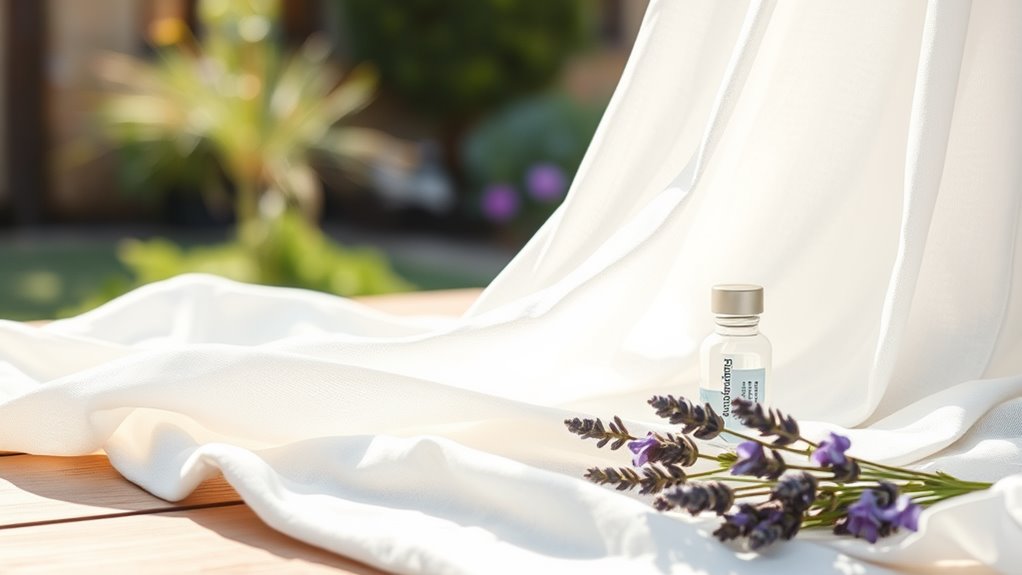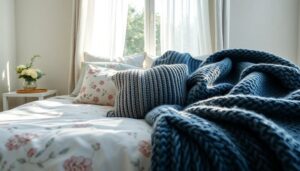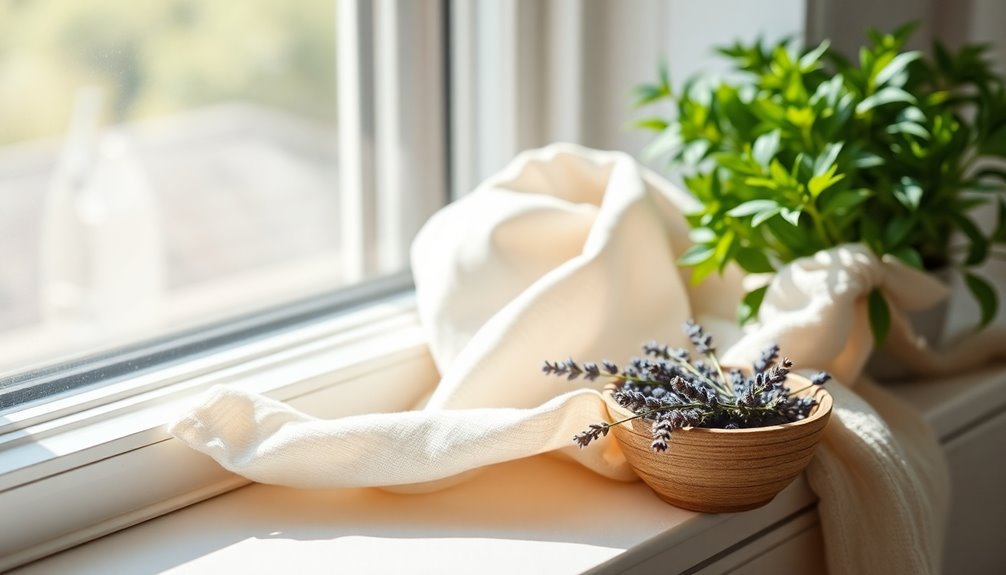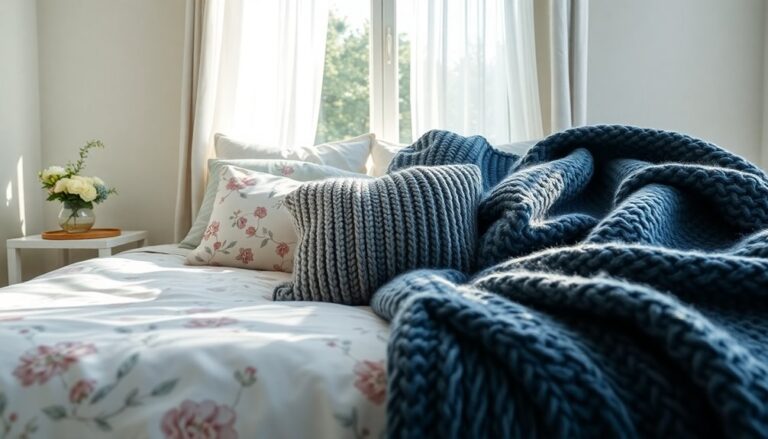Linen's breathable and moisture-wicking properties make it an excellent choice for skin health. It's hypoallergenic, reducing the likelihood of skin reactions and irritation, as it naturally regulates temperature. Its antimicrobial qualities help minimize odors and keep the skin fresh. Furthermore, linen's soft fibers provide comfort by reducing friction against the skin. With proper care, linen can be a long-lasting and stylish addition to any wardrobe. By exploring further, one can discover more about its benefits and maintenance tips.
Article Highlights
- Linen's breathable nature enhances airflow, keeping the skin cool and comfortable, especially in warm conditions.
- Its moisture-wicking properties draw moisture away from the skin, reducing irritation and promoting dryness.
- Linen's hypoallergenic fibers minimize the likelihood of skin reactions, making it suitable for sensitive skin.
- The fabric's antimicrobial features help reduce bacteria and fungi, minimizing odors and promoting a cleaner environment.
- Linen becomes softer with each wash, improving comfort while maintaining its skin-friendly qualities.
What Is Linen and How Is It Made?

Linen, a fabric prized for its breathability and durability, is made from the fibers of the flax plant. Its origins trace back thousands of years, with evidence of linen production found in ancient Egypt and Mesopotamia. The process begins by harvesting the flax, then soaking the stalks to separate the fibers from the woody core. Afterward, the fibers are dried, spun into yarn, and woven into fabric. This labor-intensive method reflects the high quality and strength of linen. Unlike other textiles, linen's unique properties come from the flax plant itself, making it a natural choice for those seeking comfort. Comprehending linen's origins and production highlights its significance in the realm of textiles and its lasting appeal.
Breathability and Moisture-Wicking Properties
Linen's breathability and moisture-wicking properties make it a popular choice for skin health. It allows improved airflow, keeping the skin cool and comfortable, especially in warm conditions. Moreover, its natural moisture control helps prevent irritation and maintains a balanced environment for the skin.
Enhanced Airflow Benefits
With regard to fabric choices for skin comfort, the breathability and moisture-wicking properties of linen stand out. This linen fabric offers improved airflow, allowing air to circulate freely around the skin. As a result, it helps keep the body cool, particularly in warmer climates or during physical activity. The lightweight nature of linen additionally reduces the likelihood of skin irritation caused by trapped heat and moisture, making it a smart choice for sensitive skin. Its ability to draw moisture away from the skin further contributes to overall comfort. People seeking a natural fabric that promotes airflow and minimizes discomfort will find linen to be an excellent option, effectively combining style and functionality for everyday wear.
Natural Moisture Control
Even though many fabrics struggle to manage moisture effectively, linen surpasses in providing natural moisture control through its superior breathability and moisture-wicking properties. This unique fabric helps maintain skin hydration, making it a popular choice for those seeking comfort and wellness.
Key benefits of linen's moisture control include:
- Breathability: Allows air circulation, preventing overheating.
- Moisture-wicking: Draws sweat away from the skin, keeping it dry.
- Natural fibers: Less likely to irritate sensitive skin.
- Temperature regulation: Keeps the body cool in hot weather.
- Durability: Retains its properties over time, ensuring long-lasting benefits.
Hypoallergenic Benefits of Linen

Owing to its natural fibers, linen is often considered a hypoallergenic fabric, making it an excellent choice for those with sensitive skin. Unlike synthetic materials, linen is less likely to cause skin reactions, which can be a significant concern for many individuals. Its breathable nature helps to regulate temperature and moisture, reducing the chances of irritation. Furthermore, linen's resistance to dust mites and mold contributes to allergy prevention, making it a favorable option for allergy sufferers. By choosing linen products, people can enjoy comfort without compromising their skin's health. Overall, the hypoallergenic benefits of linen provide peace of mind for those looking to minimize skin reactions as they enjoy a natural and sustainable fabric.
Comfort and Softness on the Skin
In terms of comfort and softness, linen stands out because of its breathable nature and natural texture. This fabric not just feels gentle against the skin, but its moisture-wicking properties help keep the body dry and comfortable. Many find that linen's unique qualities make it an ideal choice for those seeking both luxury and practicality in their clothing.
Breathable Fabric Advantages
Since linen is known for its breathability, it offers remarkable comfort and softness against the skin. This natural fabric guarantees a pleasant wearing experience, making it a favorite in linen fashion. Its unique properties contribute to a cozy feel as it provides vital skin benefits.
Some key advantages of breathable linen include:
- Excellent moisture-wicking capabilities
- Temperature regulation for warm weather
- Soft texture that reduces skin irritation
- Lightweight feel, promoting ease of movement
- Long-lasting linen durability, maintaining quality over time
Natural Texture Benefits
Linen's natural texture improves comfort and softness on the skin, making it an ideal choice for those seeking a gentle touch. This fabric is known for its slight irregularities, which create a unique feel that many find soothing. Unlike synthetic materials, linen allows for a more breathable experience, reducing irritation during wear. Its soft fibers glide against the skin, minimizing friction and promoting a sense of relaxation. Furthermore, linen becomes softer with each wash, enhancing its skin benefits over time. For individuals with sensitive skin, choosing linen can lead to a more enjoyable wearing experience, as it tends to be hypoallergenic and less likely to cause reactions. In the end, linen's natural texture offers a perfect blend of comfort and care for the skin.
Moisture-Wicking Properties
Although many fabrics can trap moisture, linen stands out with its exceptional moisture-wicking properties, making it a highly comfortable choice for skin contact. This natural fiber not just absorbs moisture efficiently but additionally helps regulate skin hydration, ensuring a pleasant experience.
Some key benefits of linen's moisture-wicking abilities include:
- Effective moisture absorption that keeps skin dry
- Improved breathability, promoting air circulation
- Quick-drying nature, preventing dampness
- Soft texture that feels gentle against the skin
- Temperature regulation for comfort in various climates
Temperature Regulation for All Seasons
In relation to comfort, nothing compares to linen's exceptional ability to regulate temperature throughout the year. Its unique fibers allow it to adapt to temperature fluctuations, keeping the skin cool in the summer and warm during colder months. This seasonal adaptability makes linen a versatile choice for various climates. When temperatures rise, linen's breathability helps wick away moisture, providing a rejuvenating feel against the skin. Conversely, in cooler weather, its insulating properties trap warmth without causing overheating. This balance guarantees that individuals remain comfortable regardless of the season. For those seeking fabric that improves their comfort as well as supporting skin health, linen stands out as an ideal option that meets the demands of year-round wear.
Linen's Antimicrobial Properties

The comfort provided by linen extends beyond temperature regulation; it furthermore boasts remarkable antimicrobial properties. These natural benefits make linen an excellent choice for those concerned with skin health.
Linen's antimicrobial properties offer several advantages, including:
- Reducing bacteria and fungi on the skin
- Minimizing odors caused by perspiration
- Promoting a cleaner sleeping environment
- Supporting overall skin health
- Enhancing comfort for sensitive skin
How to Care for Linen Fabrics
Although caring for linen fabrics may seem intimidating, it's surprisingly straightforward. For effective linen cleaning, it's best to wash linen items in cold water on a gentle cycle. Avoid using bleach, as it can weaken the fibers. Air drying is ideal, but if using a dryer, opt for a low heat setting to prevent shrinkage.
When it comes to linen storage, verify the fabric is clean and completely dry to avoid mildew. Store linen in a cool, dry place, preferably in breathable cotton bags or boxes to protect it from dust and pests. By following these simple steps, anyone can maintain the beauty and durability of their linen fabrics while enjoying their skin-friendly benefits.
Styling Tips for Incorporating Linen Into Your Wardrobe
Although many might think linen is only suitable for casual settings, it can effortlessly improve any wardrobe. With its breathable and lightweight nature, linen outfits can be styled for various occasions. Here are some tips for incorporating linen into your daily looks:
- Layer with denim: Pair a linen shirt with jeans for a relaxed vibe.
- Dress it up: Choose a linen dress and accessorize with statement jewelry.
- Mix textures: Combine linen with cotton or silk for interesting contrasts.
- Footwear matters: Opt for sandals or loafers to maintain a casual yet chic aesthetic.
- Play with colors: Experiment with different shades to keep your linen outfits fresh and exciting.
These styling tips guarantee that linen remains a versatile choice in your wardrobe, allowing for effortless casual styling.
Sustainable and Eco-Friendly Aspects of Linen
Incorporating linen into a wardrobe not just offers style but likewise aligns with sustainable and eco-friendly practices. Linen is derived from the flax plant, which thrives with minimal water and no need for harmful pesticides, making it a product of sustainable farming. This natural fiber is biodegradable, ensuring that it won't contribute to landfill waste when it's time to dispose of it. Additionally, the cultivation and production of linen require less energy compared to synthetic fabrics, promoting eco-friendly production methods. By choosing linen, consumers can support environmentally responsible choices as they enjoy the fabric's numerous skin benefits. Ultimately, linen stands out as a fashionable and conscientious choice in an increasingly eco-aware world.
Frequently Asked Questions
Can Linen Help With Skin Conditions Like Eczema or Psoriasis?
Many wonder if linen can help with skin conditions like eczema and psoriasis. It's known for its breathability and moisture-wicking properties, which can provide eczema relief by reducing irritation. Furthermore, linen's natural fibers are less likely to aggravate sensitive skin, making it a good choice for psoriasis management. Although it won't cure these conditions, incorporating linen into daily life might offer individuals some comfort and relief from their symptoms.
Is Linen Suitable for Sensitive Skin Types?
They say, "A soft answer turns away wrath." For those with sensitive skin, linen's breathable fabric and hypoallergenic properties make it a suitable choice. It allows air circulation, reducing the risk of irritation and discomfort. Linen's natural fibers are less likely to provoke allergic reactions, offering comfort without sacrificing style. Consequently, individuals with sensitive skin can find relief and ease by incorporating linen into their wardrobe, ensuring their skin feels loved and cared for.
How Often Should I Wash Linen to Maintain Skin Benefits?
When considering washing frequency for linen, it's crucial to keep fabric care in mind. Experts suggest washing linen every two to three weeks, depending on use and personal preference. Regular washing helps maintain its freshness and prevents skin irritations. Nevertheless, it's important to use a gentle detergent and avoid harsh chemicals to preserve the fabric's integrity. By following these guidelines, one can enjoy the benefits of linen during ensuring their skin remains healthy.
Does Linen Help Reduce Skin Irritation From Sweat?
In a world where fabrics dance with nature, linen emerges as a wise guardian of skin. It's known for its remarkable sweat absorption, drawing moisture away and keeping the skin dry. This helps in temperature regulation, allowing the body to breathe, especially during sweltering days. By reducing friction and irritation, linen becomes a gentle embrace for skin, ensuring comfort even amidst the chaos of heat. For many, it's truly a fabric of solace.
Can Wearing Linen Improve Overall Skin Health?
Wearing linen can certainly improve overall skin health because of its unique properties. Its breathability benefits allow air to circulate, helping to keep the skin cool and reducing the risk of irritation. Furthermore, linen's moisture-wicking qualities draw sweat away from the skin, preventing discomfort and potential breakouts. By choosing linen, individuals may find their skin feels healthier and more comfortable, especially in hot or humid conditions, nurturing a better overall skin experience.









